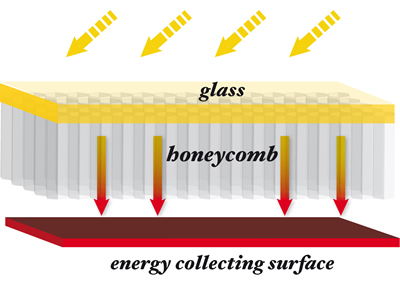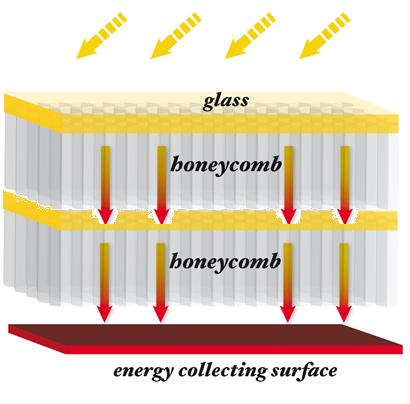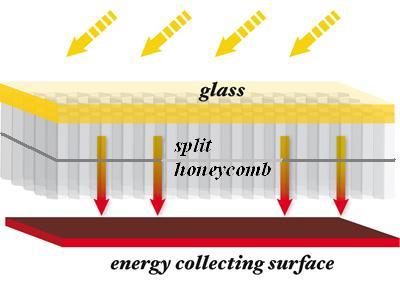In the late 80’s at school we took two layers of bubble wrap and put it beneath the glass sheet in a solar thermal panel. It improved winter efficiency of the panels quite a bit. However, the bubble wrap melted as soon as the temperature went up, as spring began.
The two layers of bubble wrap were replaced by a checker board pattern of very thin, 1 inch tall plexiglass, overlapped in a ~1/2 inch square pattern. This was later doubled up, glass, honeycomb, glass, honeycomb, heat sink, this increased efficiency. The outer layers of glass and honeycomb were nothing more than dead air space used as insulation.
A company called TIGI recently reinvented the wheel. The panels they created look like this.
Our first iteration along the same lines looked almost identical to the image above. The second iteration was as shown in the following image.
With an extra layer of tempered glass the costs were to high for production. So the following design was created but never produced. The honeycombs were to be split down the middle, the upper and lower portions are separated by a thin layer within the honeycomb. Much like the end cap on a honeycomb in a bee hive, only halfway down the honeycomb. This makes the upper section insulation, equivalent or better than a double pane window, in the lower section heat is stored and transferred to the heat sink, improving performance.



In your project from the 80s, where you realised improved thermal performance, what was the transmission loss from the insulating layers? Any idea what is the transmission loss from tigi’s honeycomb layer?
Truth be told there are to many variables for a simple answer on either question. It would be a huge multi-line x-y chart based on the kW/m^2, outside temperature, inside temperature, depth of the honeycomb, and how big the upper surface area of the honeycombs are.
By transmission losses do you mean Watts radiated outward per m^2? That would again be based on internal vs external temperatures, and the cell size.
I should had been more specific…I had actually meant the transmission loss of incoming radiation from the honeycomb/insulating layer. As such, the thicker the insulation, the higher the transmission loss, but Tigi mentions the high transparency level of their honeycomb, as one of factors contributing to the high efficiency of their panels.
The best incoming transmission levels I’ve seen listed for “affordable” multi-wall plexi sheets is about 75%-80%, and was wondering how much higher transmission Tigi might have achieved, to obtain their higher performance.
If Tigi’s transmission level is only a few % points higher than what’s possible with multiwall plexi sheets , then one should be able to results that are close to Tigi’s with inexpensive plexi-sheets as well. As you have mentioned, your old experiment with bubblewrap, which definitely would have had a much lower transmission, nonetheless did still yield a “much better performance”, so I was wondering if you had happened to capture any transmission level metrics at that time, and also if you had seen any transmission level figures from Tigi .
I’m working on improving the daily yield from an evaporation system to reclaim used water, using plastic multi-wall panels for the basin, similar to your note on the extruded plastic case with foam insulation.
But even better than foam insulation, there’s an interesting vacuum insulation panel from va-q-tec (http://www.va-q-tec.com), which can significantly reduce thermal losses from the evaporation basin. Now, if a clear vacuum panel can be used for the incoming radiation layer, instead of a honeycomb , I think it can significantly bump up the efficiency. I’ve just checked with them about a clear vacuum panel, and they say there is one, but still under development.